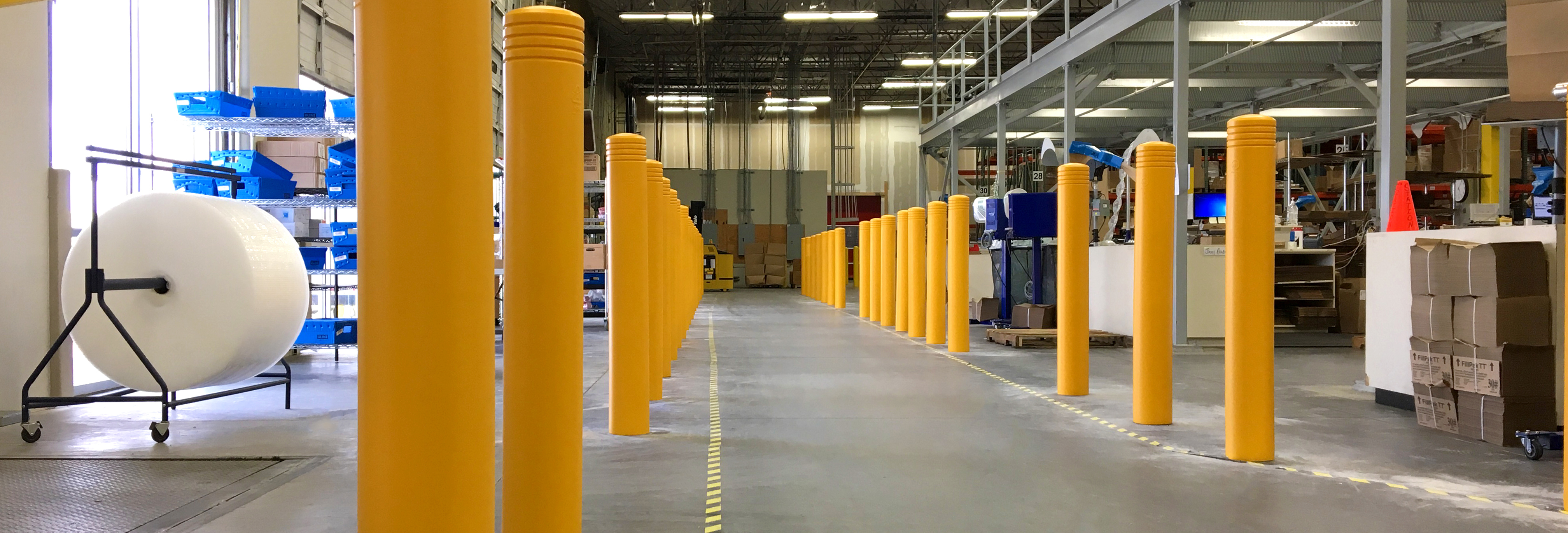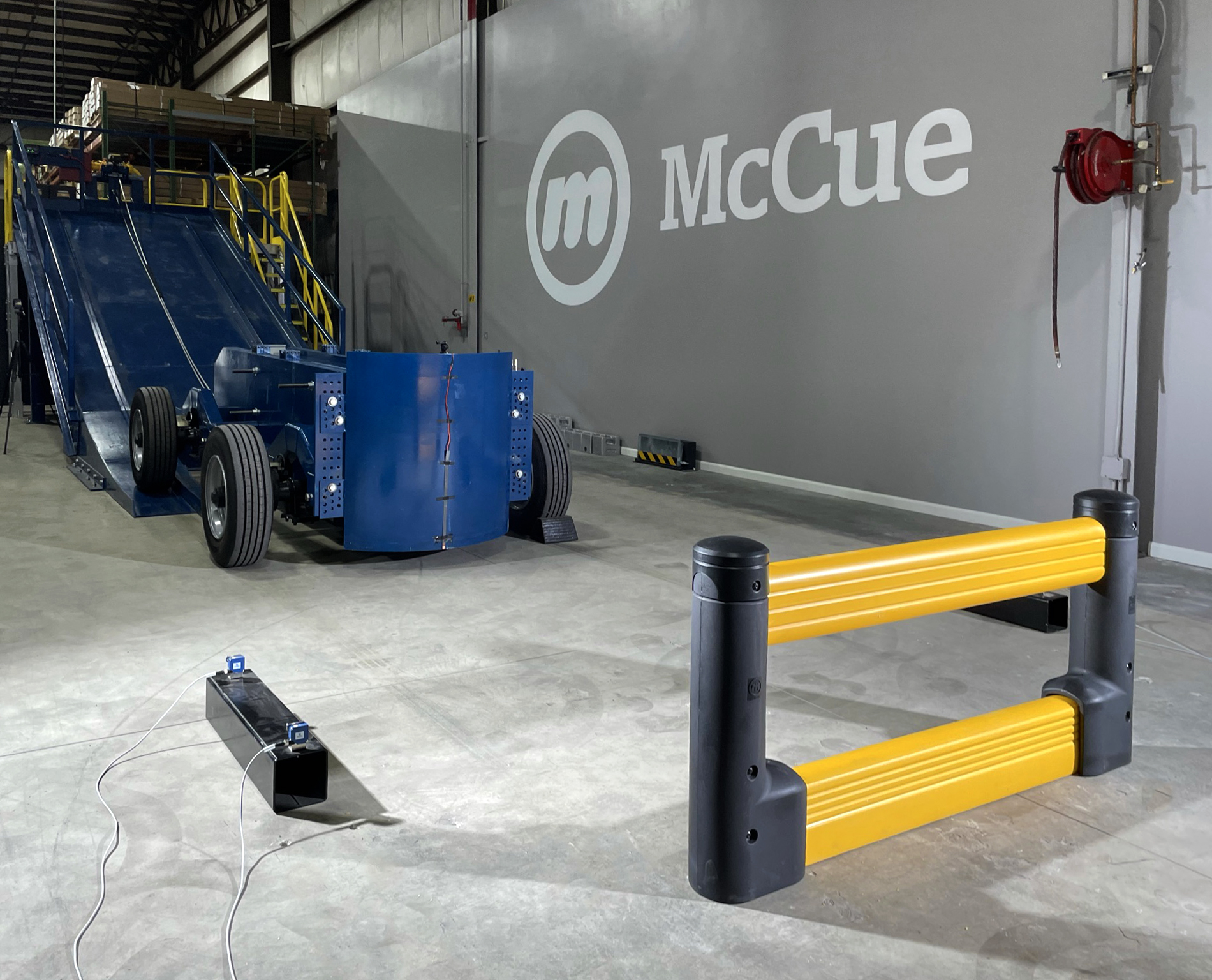Industrial safety barriers have been proven to keep people safe and prevent workplace accidents, but only recently there has been a formal 3rd-party testing standard for them! Without crucial, objective testing, it is difficult for potential buyers to compare various safety product options and ensure that a barrier works just as intended — to save people's lives.
Due to this gap, the Protective Guarding Manufacturers Association (ProGMA) worked in coordination with other industry authorities to write the first standardized test method for industrial guardrail barriers and post systems. Published last year, ANSI MH31.2 determines strength ratings by a safety barrier's weakest point and ensures this objective 3rd-party standard for safety barriers.
About The New Standard
ANSI MH31.2 includes:
- A test method with various impact speeds (either three, five or seven miles per hour) and surrogate test vehicle weight (from 9,000 pounds to 20,000 pounds) that can be used to replicate the kind of powered industrial truck impacts that can occur in manufacturing, warehousing or distribution environments. Previously, there were no standardized parameters for manufacturers of guardrail barriers and posts to use when performing independent testing of their products.
- A requirement that testing to be performed at an ISO/IEC 17025 accredited testing facility.
The Authors
ANSI MH31.2 was written in partnership between ProGMA, industry-leaders, and Texas A&M Transportation Institute (TTI), a leader in third-party testing.
Before ANSI MH31.2-2021, there was no official safety standard for the use of evaluating the performance of industrial guardrail barriers and posts. ANSI MH31.2 outlines a test method that provides a variety of selection options for both gross vehicle weight and impact speed which are predetermined prior to testing. A surrogate test vehicle, designed to simulate a powered industrial truck of similar weight, is then driven to the chosen speed just prior to impact.
On the date of approval of this standard, ProGMA consisted of the following member companies:
- Adrian's Safety Solutions
- A-SAFE INC
- Bluff Manufacturing
- Boplan USA Inc.
- Carron Net Company, Inc.
- Damotech, Inc.
- Folding Guard®
- Heartland Engineered Products, LLC
- Husky Rack & Wire
- InCord
- Industrial Netting
- Jesco Industries, Inc.
- McCue Corporation
- Mezzanine Safeti-Gates Inc.
- SICK, Inc.
- SlowStop Guarding Systems, LLC
- SpaceGuard Products, Inc.
- Steel King Industries, Inc.
- Troax, Inc.
- Wildeck, Inc.
- WireCrafters, LLC
Third-Party Testing
In order to confirm objectivity, ANSI MH31.2 requires an accredited third-party testing lab to certify the results — particularly an ISO/IEC 17025 accredited testing facility. The International Organization for Standardization/International Electrotechnical Commission, aka "ISO/IEC," enables laboratories to demonstrate that they operate competently and generate valid results, thereby promoting confidence in their work both nationally and around the world.
What that also means is an accredited third-party, like Texas A&M Transportation Institute TTI, must install a product and perform its test using their own equipment.
Importantly, this is different from third-party witnessing, which occurs when a flexible guardrail provider invites an accredited third-party to witness a test that the company is executing. Rather than merely witnessing a test, third-party testing certifies a safety barrier's impact rating because it is performed and tested by them. With MH31.2, it is the first and only North American standard for guardrail impact testing.
According to ProGMA, here are the features to consider when choosing guardrails and related components:
- Customization capability in terms of rails height
- Easy installation
- The ability to absorb the impact of moving vehicles
- High-visibility finishes in OSHA-approved colors
- The ability to expand or relocate guardrails as needed
- Mounting posts that can absorb impact and remain in place
- Removable guardrails are optimal where frequent access is required. They can swing out of the way or be taken off the hinges to allow quick accessibility
- Lift-out rails can be set aside until access is no longer required.
Features to consider when choosing safety barriers and related components:
- A strong rail-to-post connection, which can help distribute energy from an impact
- A selection of bracket styles and specialty brackets
- The ability to avoid damage to walls by mounting directly to precast concrete or masonry walls
- Mounting posts that are heavy duty
- Custom mounting posts that allow for for multiple rail applications, heights, special angles and more specific connection requirements
- Portable pedestrian safety barrier used to control construction site zones and other hazardous zones should be lightweight, compact and highly visible.
- Bollards are short vertical posts that allow personnel to pass through an area but prevent vehicles from doing so.
- Dock door protection, dock lift gates, conveyor guarding and column protectors are other available protective solutions.
Frequently Asked Questions About ANSI MH31.2 Testing Standards
What is the surrogate test vehicle weight used in ANSI MH31.2?
The surrogate test vehicle weight ranges from 9,000 to 20,000 pounds, designed to simulate powered industrial truck impacts in industrial and warehouse environments. The standardized test method uses a surrogate test vehicle that replicates the mass and impact characteristics of actual powered industrial trucks operating in distribution environments.
How do industrial guardrail barriers differ from roadside safety barriers?
While roadside safety barriers are designed for highway applications, industrial guardrail barriers tested under ANSI MH31.2 are specifically engineered for industrial vehicle traffic and warehouse environments. These guardrail barriers and barrier posts must withstand impacts from forklifts and other material handling equipment, with both gross vehicle weight and speed being critical factors in the testing methodology.
What role does the Transportation Institute play in ANSI MH31.2?
The Transportation Institute (TTI) partnered with the Protective Guarding Manufacturers Association to develop this standardized test method. TTI conducts independent testing and performed independent testing based on specific impact scenarios, ensuring that barriers and barrier posts meet rigorous safety standards for industrial guardrails.
Can ANSI MH31.2 barriers protect dock door areas?
Yes, dock door protection is a critical application for ANSI MH31.2 tested barriers. These barriers protect dock lift gates and critical infrastructure from industrial vehicle traffic. The standard includes testing for maximum dynamic penetration distance to ensure barriers can protect vital equipment near loading areas.
How are concrete or masonry walls incorporated into barrier systems?
Concrete or masonry walls can serve as anchor points for masonry walls mounting posts. The standard addresses how safety barriers attach to existing structures without compromising the wall's integrity or the barrier's performance characteristics.
What is the difference between steel mesh containment panels and guardrail barriers?
Steel mesh containment panels provide vertical protection and containment, while guardrail barriers and posts offer horizontal impact protection. Both are evaluated for evaluating performance characteristics but serve different functions in control construction site zones and distribution environments.
Are there other available protective solutions besides ANSI MH31.2 barriers?
Yes, other available protective solutions include bollards, corner guards, and physical security division products. However, ANSI MH31.2 specifically addresses industrial guardrails and vehicle impact protective devices for warehouse applications.
Understanding the Test Method and Performance Characteristics
The ANSI MH31.2 test method establishes clear performance characteristics for industrial guardrail barriers. Unlike roadside safety applications, this standardized test method specifically addresses powered industrial truck impacts common in industrial and warehouse environments.
The testing methodology evaluates how barriers and barrier posts respond to impacts from a surrogate test vehicle calibrated to match both gross vehicle weight and velocity parameters of actual powered industrial trucks. The surrogate test vehicle weight can be adjusted to simulate different forklift classes, ensuring comprehensive evaluating performance characteristics.
Protecting Critical Infrastructure and Vital Equipment
ANSI MH31.2 tested barriers protect more than just walls—they safeguard critical infrastructure and vital equipment throughout facilities. From dock door protection systems to dock lift gates, these industrial guardrails create safety zones that prevent costly damage from industrial vehicle traffic.
When choosing safety barriers, consider other manufacturers offer various configurations. Some integrate steel mesh containment panels for additional protection, while others mount directly to concrete or masonry walls using specialized masonry walls mounting posts.



